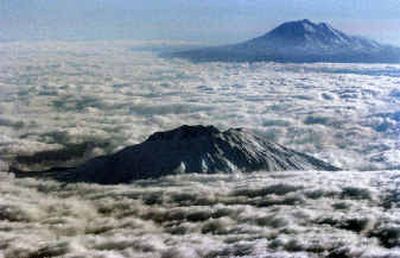Scientists short on equipment to watch volcanoes

VANCOUVER, Wash. – For lack of funds, more than a third of the nation’s “truly dangerous” volcanoes lack even a seismometer for detecting signs of an impending eruption, scientists say.
Mount St. Helens, where lava began oozing into the crater this month after a few steam bursts, is one of the dozens of volcanoes monitored by the U.S. Geological Survey in Alaska, Washington, Oregon and California.
Even at St. Helens, the most active volcano in the lower 48 states over the past 4,500 years and the most thoroughly wired mountain in the Cascade Range, scientists have scrambled to install equipment, recharge batteries and repair damaged gear.
“We think it’s serious,” Jim Quick, coordinator of the USGS volcano hazards program in Reston, Va., told the Columbian of Vancouver.
“The problem is you’re playing catch-up on the volcano then,” Quick said. “You’ve greatly shortened the response time the community has to react. You’re also putting my people at risk.”
Rep. Brian Baird, D-Wash., whose district includes St. Helens, says the payoff in public safety would be well worth the cost.
“It’s not just abstract intellectual data collection,” Baird said. “This is about predicting an event that could cost a number of lives if we don’t predict accurately.”
According to the Smithsonian Institution, 172 U.S. volcanoes have been active within the past 10,000 years and many have erupted within the past 200 years, sometimes repeatedly, Quick said.
“About 70, we feel, are truly dangerous volcanoes, which means they would pose a threat to people or property on the ground or aircraft in the air,” Quick said.
The 25 without any monitoring equipment are in remote areas of Alaska and the U.S.-affiliated Mariana Islands in the South Pacific, posing little threat to buildings or people on the ground but sitting below major airline flight paths, he said.
Gritty volcanic ash can clog aircraft engines. On Dec. 15, 1989, a jumbo jet nearly crashed after all four engines stalled as it passed through what looked like a normal cloud over Mount Redoubt in Alaska.
The silica-rich ash melted, then solidified inside the engine compartments. The flight crew managed to restart the engines and landed in Anchorage.
“The more you have monitored, the less the chance of that bad case of a pilot ending up in a (volcanic) cloud without realizing it,” said Steve Malone, a professor of earth and space sciences at the University of Washington.
“It’s this balancing act,” Malone said. “You’re working on a combination of being good and being lucky.
“If you have instruments by chance or design where problems occur, then you can look good. If something takes place where you don’t have any monitoring equipment at all, then problems can escalate very quickly.”
The volcano hazard program includes five observatories, employs about 130 people and was last budgeted at $19.7 million. President Bush has proposed $18.5 million for the next fiscal year, and “we hope to offer a few million into that,” Baird said.
He said the money at stake represents “almost rounding errors” in the total $2.4 trillion federal budget.